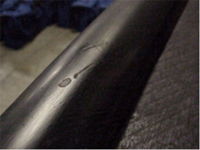Of the 350 species of termite in Australia, only 8% of these species are considered to be of economic concern, with the estimated annual damage accredited to these insects being AU$ 4 Billion.

The issue of electrical failure of cables due to termite attack has been recognised for over 100 years. In the early days, small telephone cables were found to be more prone to early failure compared to larger power cables through termite attack. The primary reason for this phenomenon being attributed to the use of metallic layers in early power cables viz, lead sheaths, steel tape or steel wire armours (these layers proved to be physical barriers to termites reaching the inner components of such cables). Where termite attacks did occur on outer servings of the larger power cables, the time to any failure would be longer as the mechanism of failure was related more to corrosion and water ingress than a direct short-circuit.
Although modern electrical cables are not nutritious for termites (they do not eat the polymeric components of the cable because they cannot digest them), such cables are frequently attacked by foraging termites, which results in electrical failure. It is a sad fact that cables amongst many other items become “collateral damage” in areas of termite activity.

Evidence of early termite attack on PVC sheathed cable
How do termites damage cables?
Termites have strong mandibles which are used to break up matter. In order to start an attack on a cable, the termites must find a weak spot (somewhere to allow a ‘purchase-point’ for their mandibles). Such a spot can be a small scar or tear, a raised area on the sheath (embossing or indent marking) or a sharp edge at a lug-off point. Once the point of attack has been identified, termites will commence an attack and continue breaking away the sheath and any underlying components until a short-circuit phase to phase or phase to earth occurs. The success of any such attack can be correlated to the hardness and finish of the outer sheaths used on the cable. Termites will readily damage flexible PVC grade compounds whereas, Rigid PVC (pipe grades), high-density polyethylene (HDPE) grades with shore D hardness > 62 and Nylon-12 with a smooth glass like finish and a shore D hardness >65 show higher resilience to attack.

Giant northern termite (Mastotermes darwiniensis) - Worker termite’s mandibles
Caption
How are cables protected from termite attack?
An incredible amount of science and engineering has gone into developing ways to protect cables from termite attack, but it’s rarely communicated to the electrical industry. The timeline below details the developments in industry over the last 50 years in Australia.
The early years
Early attempts to mitigate against termite attack involved backfilling around cables with soil containing insecticides such as DDT, Lindane, Aldrin and Dieldrin. But the harmful effects of environmental contamination and risk to workers’ health saw this practice banned throughout Australia many years ago.
1960’s
Collaborative research by CSIRO, PMG (now Telstra) and the cable industry identified Nylon-12 as being highly resistant to termite-attack. As a result, extrusion of a Nylon-12 jacket over polyethylene (PE) cable-sheathing became the industry norm in Australia. The economics of nylon-jacketed cable, in terms of raw material cost and additional processing, detracted however from its total performance.
1970’s
Cable sheathing compounds containing insecticides (particularly Sevin and Lindane) were manufactured as an alternative to nylon but it was found that, although these chemicals killed attacking termites, continued attack on the cables by follow-on members of the colony ultimately caused premature cable failure.
1970’s and 1980’s
There was further collaborative research among users, industry and CSIRO with the aim of identifying the mechanism, which made nylon resistant to termite damage, then identifying cheaper alternative materials with comparable insect resistance. It was concluded that Nylons-11 and 12 had unique blends of properties such as hardness, smooth surface finish and flexibility. The research did not reveal any plastic materials with termite resistance comparable to nylon that was sufficiently flexible to enable it to be used as a cable sheathing material.
1990’s
Pirelli (now Prysmian Group) and BICC (both cable manufacturers) were at the forefront in developing a HDPE sheathing compound that uniformly incorporates the synthetic pyrethroid ‘Cypermethrin’ as a termite deterrent. This product is known as TERMITEX®. Cypermethrin is widely used in pest-control and agriculture. TERMITEX® has completed prolonged field exposure testing by CSIRO and has been in service in some of the harshest Australian environmental conditions for over 10 years. There has been no reported termite-induced cable failures on any TERMITEX® protected cable to date.
Throughout the decades, cables have also been produced with metallic barriers such as brass, copper and stainless steel tapes as a means of combatting termite attack. These tapes being applied in time-proven configurations allowing maximum flexibility during installation while limiting tape displacement at bend points. Whilst these tapes offer effective barriers to termite attack, there are added installation requirements to ensure that these metallic tapes are brought back to earth-potential at termination. This means additional time and cost compared to the polymeric-protected cables. It is also important to ensure bend radii are respected in order to avoid any openings in the tape layer which may give termite’s access to the inner cable components.
Since effective termite protection is available through a number of manufacturing solutions, it is necessary for the user to assess their needs and weigh up any specific cable performance requirements prior to specifying a design. Consideration must be given to environmental, OH&S and installation requirements when comparing the various methods of protection.
Australian cable manufacturers have a long history and understanding of the complex design principles required to meet national and international performance standards for such cables. Those charged with the responsibility of specifying or sourcing cables for installations at risk of termite attack should contact reputable Australian cable manufacturers who can provide a list of reliable options and assist in assessing them to find the most suitable solution.